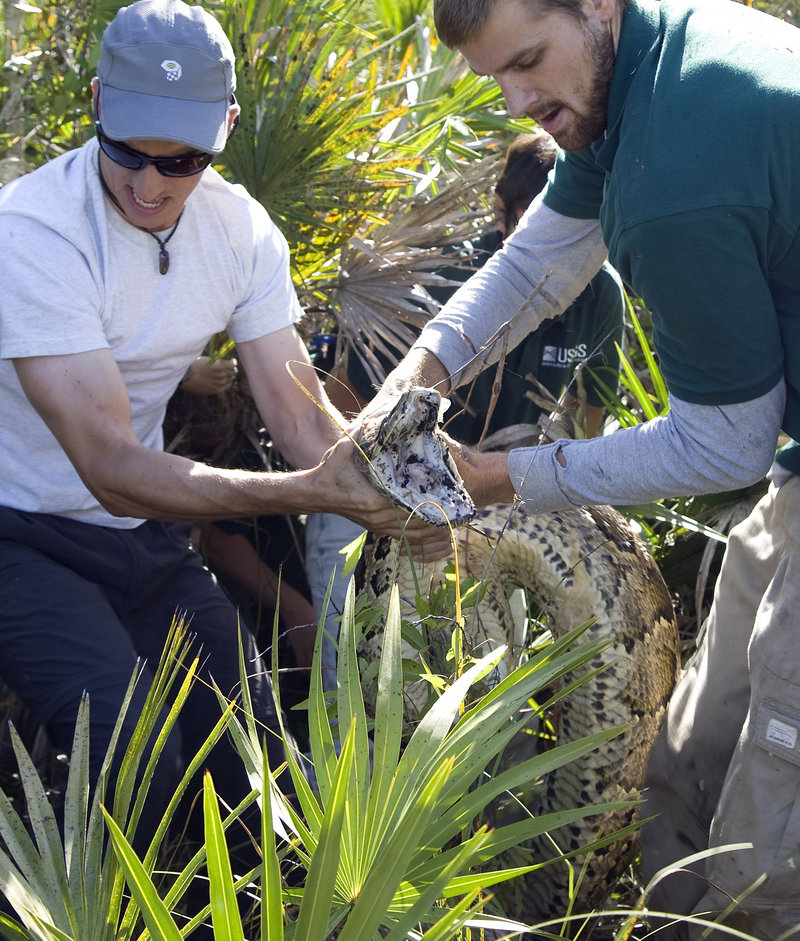EVERGLADES NATIONAL PARK, Fla. – Kristen Hart’s search for a cold-blooded killer came to an end at a perfect hideout — thick scrub brush, dense trees and shade. She crouched with three scouts and whispered.
“Do you see her?” asked Hart, a research ecologist for the U.S. Geological Survey. “Yeah, she’s in there,” answered Thomas Selby, a wildlife biologist. “I think she knows we’re here,” said Brian Smith, another biologist.
Within seconds, the 16 1/2-foot Burmese python uncoiled and made a run for it. What happened next is a drama that plays out every week or so, as state and federal biologists try to prove — or disprove — that the giant invasive snakes are the reason for the near disappearance of rabbits, opossums, raccoons, foxes and even bobcats in the southernmost section of the 1.5-million-acre Everglades.
Smith and Selby charged into the trees. “I’ve got the head!” Smith shouted. “Grab the tail!” They stumbled out with the writhing snake in a chokehold, huge mouth agape, ready to bite.
It was actually the second time biologists got their hands on Python 51 — the 51st caught. Two months ago, they surgically fitted her with a radio transmitter, motion detector and global positioning system to study her diet and movements.
Now, the snake’s days of squeezing the life out of prey and giving birth to about four dozen babies every year are over. The scientists want to retrieve their expensive equipment and the data it contains. She was euthanized last week, along with an even bigger snake, the largest ever captured in Florida, at 17 1/2 feet.
Burmese pythons are native to Southeast Asia. No one knows for certain how the invasive snake entered the park. The belief that Hurricane Andrew blew them there from exotic pet shops and houses in 1992, or that numerous pet owners released them when they grew too large, is likely a myth, according to Frank J. Mazzotti, a professor of wildlife ecology and conservation for the University of Florida.
“All it takes is three snakes,” he said, mating and laying an average of 50 eggs, and up to 100 eggs, per year.
Their population in the Everglades is estimated at anywhere between 5,000 and 100,000 by USGS. The National Park Service says that more than 1,800 pythons have been removed from the park and surrounding areas since 2002.
Some game officials and citizens have suggested sending bounty hunters with guns and machetes into the park. Bounty hunters are great at capturing snakes — when they find them, which is rare. Hunters are also known to execute small native snakes, mistaking them for python hatchlings.
“Someone could tell you there are 10 pythons in this area, and you could walk all day and not see them,” Smith said.
Pythons prefer warmth, but many in the Everglades have managed to survive hard freezes, leading some biologists to worry about their ability to adapt and travel north. The snake has already been swimming and slithering south toward the Florida Keys.
Once pythons are established, trouble seems to follow. A study co-authored by Hart, Mazzotti and other researchers showed that when pythons started to appear in large numbers in the late 1990s and early 2000s, mammals in the southernmost part of the Everglades started to disappear.
For the study, researchers traveled nearly 40,000 miles over 11 years, observing wildlife in the southern area. They found that 99 percent of raccoons, 98 percent of opossums and about 88 percent of bobcats were gone. Marsh and cottontail rabbits, as well as foxes, could not be found.
Nearly every news report blamed pythons, but the study — “Severe Mammal Declines Coincide with Proliferation of Invasive Burmese Pythons in Everglades National Park” — did not conclude that. It said more research was needed.
“You have to ask the question,” Mazzotti said. “Has a crime occurred? Yes, mammals have declined. Do pythons have a motive? You bet, they have to eat. Do they have the means? They’re like vacuum cleaners on mammals. But then you have to do a much better job of looking at cause and effect.”
Mazzotti is also examining the impact of humans, who have drained water for development. “What’s happened in the Everglades is that the depth of water has been completely screwed up by humans, and we have to ask the question if hydrology is related to the disappearance of mammals.”
Using data collected from recaptured pythons, Hart is testing her own theory. Although humans rarely see well-camouflaged pythons, she wonders whether vanishing marsh rabbits see them all the time, just before their world goes black.
“I used to see marsh rabbits down in Flamingo (a section of the park) and I don’t see them anymore,” she said. “We don’t see such dramatic declines in places that don’t have pythons, like Big Cypress,” the national preserve slightly north of the Everglades.
Python 51 is one of the keys to that research. She was first captured in February, when park workers spraying vegetation spotted her and called for help. She became the fifth snake fitted with smarter motion detector and global positioning technology since it was first deployed two years ago.
After her recapture, Hart was eager to see the data embedded in the tracking device, called an accelerometer. Its technology is similar to the Xbox and Wii digital game devices, recording data five times a second — “every pitch, yaw and roll,” Hart said.
“We can tell when they’re belly up,” she said. “We can tell if it squeezed a small item,” meaning a little creature, “because it would not take long, or that much flipping by the snake,” to squeeze its breath out and stop its heart. “But a large item would take lots of flipping.”
Accelerometers cost $2,000 each, a pricey sum for the cash-strapped USGS. When an accelerometer was lost last year in April, Hart and her team went out of their way to get it back.
“We were in water up to my waist,” said Selby. Smith, his colleague, “was holding the radio. I stepped on something hard and stood up on it. Then I stepped off and this gator splashed away.” As it swam away, the signal got weaker and weaker. “He had the accelerometer in him.”
Days later, they struck out to find the alligator. “We got the gator that got the python that had the accelerometer,” Hart said. The 10-foot alligator is currently at Zoo Miami.
“We’re hoping to get him X-rayed this week,” Hart said. “We might have to go get the equipment through one end or the other. He will be awake. You can get the mouth open. You can reach way in there. I’m sure the gator won’t like it.”
“What can we do to control this snake?” Hart said. Control is the politically correct biologist jargon for killing to drive down a population. All but one of the 52 snakes captured were humanely killed. “That’s what I’m really focused on.”
Send questions/comments to the editors.




Success. Please wait for the page to reload. If the page does not reload within 5 seconds, please refresh the page.
Enter your email and password to access comments.
Hi, to comment on stories you must . This profile is in addition to your subscription and website login.
Already have a commenting profile? .
Invalid username/password.
Please check your email to confirm and complete your registration.
Only subscribers are eligible to post comments. Please subscribe or login first for digital access. Here’s why.
Use the form below to reset your password. When you've submitted your account email, we will send an email with a reset code.